
April 2014, Vol. 33 No. 1
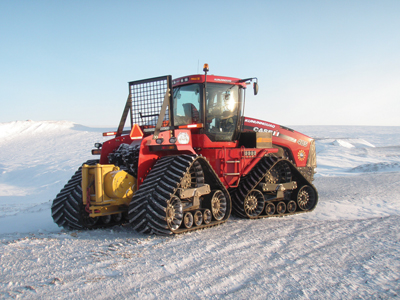
The W6G winch has a mounting bracket specifically engineered by Allied for easy installation on Quadtrac tractors.
(Photo: Jay Burnside, CPS)
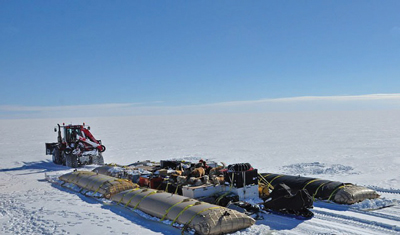
The Case IH Quadtrac, backed by the Allied W6G winch, transports a huge volume of supplies over vast distances in extreme Arctic conditions. The winch allows the Quadtrac to pull the load ahead when traction is insufficient, then advance normally once the load is broken free.
These tractors are supporting research in the Arctic through funding from the National Science Foundation’s Office of Polar Programs.
(Photo: Jay Burnside, CPS)
Allied Winch Keeps Things Moving
in the Frozen North
GREENLAND INLAND TRAVERSE (GrIT)
Case dealer B & G Equipment in Colorado had an unusual inquiry from CH2M Hill, a renowned international engineering consulting firm based in Colorado. CH2M Hill needed winches for Case IH Quadtrac tractors for extreme Arctic conditions. Allied had just the answer.
CH2M Hill Polar Services (CPS) is the prime contractor for the Arctic Research Support and Logistics Services (ARSLS) Contract from the National Science Foundation (NSF). As part of that contract, CPS operates a project called the Greenland Inland Traverse (GrIT). GrIT is funded by the NSF.
The primary purpose of the GrIT project is to provide logistical support to Summit Station, Greenland. At 72º north latitude and 10,600 ft (3,255 meters) above sea level, Summit is the only high latitude, high altitude research platform in the northern hemisphere.
Located at the highest point of the ice cap, this NSF supported facility operates year-round in an extreme, high polar environment. Traditionally, logistical support has been provided exclusively via ski-equipped aircraft. The economic and environmental costs of this approach called for an alternative – the GrIT Project. Supplies are now towed overland approximately 1,400 miles (2,200km) round trip.
The traverse travels with three Case IH Quadtrac tractors outfitted with Allied W6G winches. The winches are used where crevasses, side slopes and hills pose the greatest difficulties.
The tractor payload is pulled on High Molecular Weight (HMW) plastic sheets. Occasionally the load becomes “stuck” to the snowpack through a process known as “adfreeze.” This typically occurs in the morning or after the tractor sits in place for an extended period. Once the load becomes trapped in this way, the Quadtrac is unable to get it moving again due to insufficient traction. To break the load free, the tractor digs itself into the snow to resist sliding.
The winch generates the line pull needed to pull the load free, and then the tractor can pull the load normally with minimal resistance.
Working in temperatures well below zero, the winch has Arctic rated fluids and a cold-weather seal package to keep things running despite the cold.
The Quadtrac machine with Allied W6G has gained strong acceptance in the Arctic for its versatility in support of a wide range of activities in oil exploration, infrastructure development, research, and mapping.
Another Case dealer, Yukon Equipment in Anchorage, Alaska, has fielded a fleet of Quadtrac tractors with “winterized” winches for oil exploration and seismic work in the Arctic. They have worked with Allied since 2002 to pioneer this combination and to refine the set-up of the Quadtrac to maximize its utility in the Arctic (see Winchlines, Vol 22, No. 2).
According to Yukon Sales Manager Richard Kimball, there’s a lot involved in configuring a Quadtrac for this harsh environment. Yukon has learned the tricks to make the Quadtrac more effective in their markets, and the Allied winch is a key component.
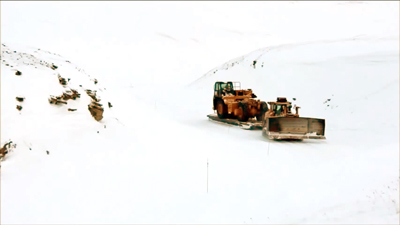 A Cat D8T tractor hooks the Allied W12E winch drawbar to a sled loaded with a heavy mining truck...
A Cat D8T tractor hooks the Allied W12E winch drawbar to a sled loaded with a heavy mining truck...
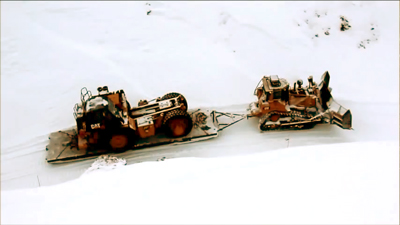 and pulls it through a permafrost ravine.
and pulls it through a permafrost ravine.
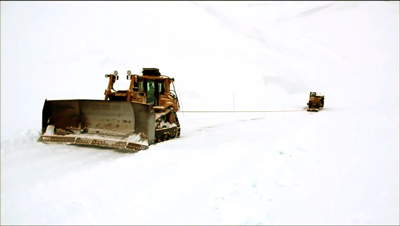 When going uphill or at poor traction spots, the D8T secures the winch cable to the sled, puts the winch in “brake-off” mode, and pays out wire rope as it climbs the hill.
When going uphill or at poor traction spots, the D8T secures the winch cable to the sled, puts the winch in “brake-off” mode, and pays out wire rope as it climbs the hill.
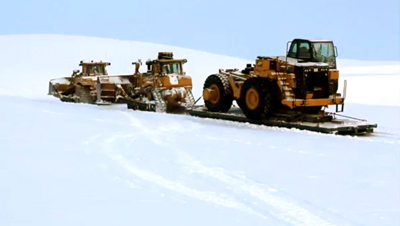 As the tractor regains traction, it winches in the sled and continues the journey.
As the tractor regains traction, it winches in the sled and continues the journey.

SVEA COAL MINE EQUIPMENT TRANSPORT
It’s not unusual for a coal mine to be remote, but this one takes remote to a new meaning. Located on the archipelago of Svalbard at 78º north latitude in the Barents Sea, this coal mine is completely isolated from mainland Europe and in Arctic conditions year-round. To transport the heavy equipment that is needed at the mine site, it has to travel over the snowpack on sleds towed by large track-type tractors.
Cat dealer Pon Equipment in Oslo, Norway recently delivered a new D8T tractor to their customer AF Gruppen AS and needed a new winch to go with it. The customer had been using an Allied W8L winch for nearly 10 years on a D8R without any problems, and they wanted the same reliability and pulling power they had come to expect.
The track across the snow from the sea port to the mine site runs about 45 miles (70 km) over uneven terrain. When the slope gets too steep for the D8T to have sufficient traction to climb the grade with a heavily loaded sled behind, the Allied winch solves the dilemma.
The tractor advances up the slope with the winch in brake-off mode, leaving the load in place. The cable pays off the winch drum smoothly while maintaining enough tension to prevent cable “bird-nesting.” At the top of the ledge, the tractor beds itself into the snow for additional traction, then shifts the winch to line-in mode to bring the load forward.
The W8L PTO-driven winch can develop a pulling force about double the tractor drawbar pull. If the tractor doesn’t slide, there is plenty of pulling power to bring the sled up the hill.
You can see a YouTube video of this winch in action at: http://www.youtube.com/watch?v=CcRoaiNcb5s
Go to the 11-minute mark to quickly get to the winching portion of this video. Our thanks to Pål Brandvold, Key Account Manager at Pon Equipment in Oslo, for providing this link.

This nimble D6N with Allied W6G winch can get onto the rails from almost anywhere and clears away snow from an avalanche to open up the rail line. The notched track shoes keep the tractor on the rails.
(Photo: Steve Fischer, NC Machinery, Anchorage, AK)
AVALANCHE CLEARING TRACTOR
Alaska is the 49th US state, having joined the United States in 1959. Even before statehood, Alaska was using a publically owned rail system to move people and goods efficiently year-around. With the railway often located in steep valleys at the foot of high mountains, avalanches are a common occurrence in winter, closing the rails to train travel on frequent occasions.
inter of 2011-2012 was especially difficult, with record snowfall amounts and serious rail travel delays.
To get the rails opened up more quickly, the Alaska Railroad Corporation (AKRR) developed a novel solution. Working with Cat dealer NC Machinery in Anchorage, they adapted a D6N track-type tractor with a 6-way blade and an Allied W6G winch into a machine that can clear the railway of snow quickly and safely.
The traditional plowing method is to attach a snowplow to the front of a locomotive. In avalanche conditions, the snow volume is heavy and localized and the locomotive may not be able to push the snow aside.
Enter the D6N. It has both great mobility and immense power to move the snow. To keep it centered on the railway, the D6N grousers were notched to allow it to operate as if it had flanged wheels, following the rail line with no steering required (see photo).
Operating in an avalanche zone, the tractor is always vulnerable to fresh avalanches at any time. The high line pull of the W6G winch helps the D6N get out of difficult spots and continues its job of opening the rail line.